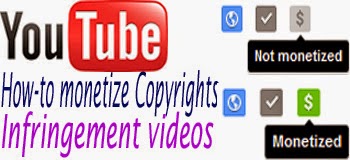How to Deal with False Third-party Matches on YouTube-2015
Several months ago, I met
Michael Strange through YouTube. I noticed immediately the success of Michael’s YouTube endeavors and asked him if he could please help me out.
He was game, thank goodness, and he walked me through the steps on
how to fix my YouTube channel. One of these was to address false
third-party matches on the service.
Third-party matching indicates that your video is understood to
infringe some third party’s copyright. You can’t monetize videos on
which these matches are outstanding, so if you’re trying to make money
through YouTube, third-party matches can be a problem.
Finding third-party matches
First and foremost, you might not even know if you have third-party
matches. I knew I had some, but I wasn’t aware that videos that were
entirely mine were flagged for copyright issues!
To see if you have third party matches on YouTube, just log in to
your account and go to your Video Manager. On the left side of the Video
Manager you’ll see an entry for Copyright Notices. Select that, and
you’ll see all your movies that have third-party matches.

In the list of movies you’ll see notes like “matched third-party
content”. You have to address each one as a separate dispute, so
hopefully you don’t have many.
To get started, click the blue hyperlink that states the reason for the copyright notice.

You’ll be taken to a screen that looks something like this:

Here you can see a general information statement about copyright
matches, followed by a link that states, “I want to learn more about the
dispute process.” When you select that, you’ll see some information
about when you can and can’t dispute things.
Disputing the match
If, after you have read all the reasons to dispute or not to dispute
the matches, you still feel that you should not have copyright issues,
then you will want to dispute the claim. For example, a video that I’d
created in my backyard had been flagged as a third-party match, but it
was all my own content, so I decided to dispute it—and won.
To dispute a copyright notice, go to the bottom of the dispute
information. You’ll see a link that says, “I believe this copyright
claim is not valid.”

You will be taken to a screen that asks you to select the reason for
your dispute. Carefully select your reason and click on Continue.

You will then be taken to a screen where you will be asked to confirm that you own all the rights to the content.
Please note: the example that I am using here is not a valid
one to dispute—a song plays in the background of my video that is not
my content, therefore technically I cannot dispute it. I am using these
screenshots to show the steps only.

After you click Continue, you will be taken to the dispute form.

Fill in the form and submit it. Then, you’ll want to walk through the
same steps with any other videos that have false third-party matches
flagged for them.
The dispute process
YouTube has recently improved the dispute process and will send you an email when a dispute claim has been received.
At that time you should check the status of the relevant movie and
add the monetization details if necessary. You may need to manually
check your disputes to see if you’re still awaiting an outcome, or some
other problem has arisen.
If the dispute is resolved in your favor, it just drops off the
copyright match list. You’ll need to go hunting for the movie in your
video manager to then monetize it.
Unexpected matches
Like me, you can sometimes have a problem if the TV or radio was
playing in the background when you recorded your video, as legally you
would then be using that music in your movie without a valid license,
and recording industry companies such as Sony could have a legitimate
dispute against you.
In those cases, there is nothing you can do if you wish to monetize
the movie, other than to remove the movie from YouTube, replace the
audio track, and then re-upload the corrected movie.
Have you had third-party matches on YouTube that you’ve disputed? How have they gone? Share your stories in the comments.












